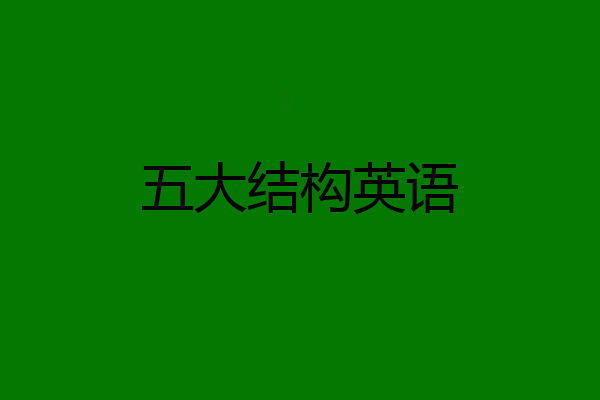
撒野撒野王子
英语中的五种基本句型结构一、句型1: Subject (主语) + Verb (谓语) 这种句型中的动词大多是不及物动词,所谓不及物动词,就是这种动词后不可以直接接宾语。常见的动词如:work, sing, swim, fish, jump, arrive, come, die, disappear, cry, happen等。如:1) Li Ming works very hard.李明学习很努力。2) The accident happened yesterday afternoon.事故是昨天下午发生的。3)Spring is coming.4) We have lived in the city for ten years.二、句型2:Subject (主语) + Link. V(系动词) + Predicate(表语)这种句型主要用来表示主语的特点、身份等。其系动词一般可分为下列两类:(1)表示状态。这样的词有:be, look, seem, smell, taste, sound, keep等。如:1) This kind of food tastes delicious.这种食物吃起来很可口。2) He looked worried just now.刚才他看上去有些焦急。(2)表示变化。这类系动词有:become, turn, get, grow, go等。如:1) Spring comes. It is getting warmer and warmer.春天到了,天气变得越来越暖和。2) The tree has grown much taller than before.这棵树比以前长得高多了。三、句型3:Subject(主语) + Verb (谓语) + Object (宾语)这种句型中的动词一般为及物动词, 所谓及物动词,就是这种动词后可以直接接宾语,其宾语通常由名词、代词、动词不定式、动名词或从句等来充当。例:1) He took his bag and left.(名词) 他拿着书包离开了。2) Li Lei always helps me when I have difficulties. (代词)当我遇到困难时,李雷总能给我帮助。3) She plans to travel in the coming May Day.(不定式)她打算在即将到来的“五一”外出旅游。4) I don’t know what I should do next. (从句)我不知道下一步该干什么。注意:英语中的许多动词既是及物动词,又是不及物动词。四、句型4: Subject(主语)+Verb(谓语)+ Indirect object(间接宾语)+Direct object (直接宾语)这种句型中,直接宾语为主要宾语,表示动作是对谁做的或为谁做的,在句中不可或缺,常常由表示“物”的名词来充当;间接宾语也被称之为第二宾语,去掉之后,对整个句子的影响不大,多由指“人”的名词或代词承担。引导这类双宾语的常见动词有:buy, pass, lend, give, tell, teach, show, bring, send等。如:1) Her father bought her a dictionary as a birthday present.她爸爸给她买了一本词典作为生日礼物。2)The old man always tells the children stories about the heroes in the Long March.老人经常给孩子们讲述长征途中那些英雄的故事。 上述句子还可以表达为:1)Her father bought a dictionary for her as a birthday present.2)The old man always tells stories about the heroes to the children in the Long March.五、句型5: Subject(主语)+Verb (动词)+Object (宾语)+Complement(补语)这种句型中的“宾语 + 补语”统称为“复合宾语”。宾语补足语的主要作用或者是补充、说明宾语的特点、身份等;或者表示让宾语去完成的动作等。担任补语的常常是名词、形容词、副词、介词短语、分词、动词不定式等。如:1)You should keep the room clean and tidy. 你应该让屋子保持干净整洁。(形容词)2) We made him our monitor.(名词)我们选他当班长。3) His father told him not to play in the street.(不定式)他父亲告诉他不要在街上玩。4)My father likes to watch the boys playing basketball.(现在分词)5) Yesterday I had a picture taken with two Americans.(过去分词)


cHeN&Li$Li
主谓 I see主谓宾 I sak you to tell the story 主谓宾 宾补 I can see a bird flying in the sky主系表 she is a beautiful girl主谓双宾 I give you the pen as a birthday present

一缕青丝万缕愁
英语句子的基本结构可以归纳成五种:1.S V(主语+谓语)例如:She smiled. (smile是不及物动词vi.,做句子的谓语)在主谓结构中,谓语动词必须是不及物动词(即后面不能接宾语的动词)。2.S V P (主语+系动词+表语)例如:She is a beautiful girl. (is是be动词,即系动词)在主系表结构中,系动词是判定该结构的重要标志。英语中常见的连系动词 有:(1)be动词 (am, is, are, was, were)(2)感官系动词:feel(感觉,感到), smell(闻起来), sound(听起来),taste(尝起来), look (看起来)(3) 变化系动词:become(变成,变得), grow(长成,长得), turn(变成), fall(落下来), get(变得), go(变得), come (来)(4) 状态系动词: seem(看起来,似乎), keep(保持), remain(保持),stay(保持), appear(显得,似乎).
3. S V O (主语+谓语+宾语)例如:I like my job. (like是个及物动词vt.,做句子的谓语,后面可以接宾 语)4. S V IO DO (主语+谓语+间接宾语+直接宾语)例如:He gave me some books. (give是个及物动词vt.,做句子的谓语,后面可以接双宾语,me是间接宾语,some books是直接宾语,直接宾语指物,间接宾语指人)
5. S V O C (主语+谓语+宾语+宾语补足语)例如:I found the book interesting. (the book 是句子的宾语,interesting是对宾语the book 的补充说明,即补足语,因为是对宾语的补充说明,所以是宾语补足语。如果是对主语补充说明,那就叫主语补足语。)